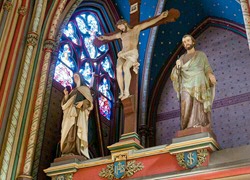Clergy in the Middle Ages actively shared their knowledge with laypersons

The idea still persists that in the Middle Ages, lay people and the clergy lived in separate worlds, and that religious knowledge was anxiously kept from the urban population. In his PhD research, Pieter Boonstra shows that this was not the case: the clergy also actively disseminated their knowledge to lay people, and had them read the same texts in the same way that they themselves did. In addition, his thesis reveals that there has always been close contact between lay people and the clergy, and that close bonds of friendship could exist between these ‘separated’ groups. Boonstra also proves that preaching was already occurred on a large scale before the Reformation, that people were interested in it, and that cities themselves were actively involved in the organization of good sermons. This also disproves a prevailing theory, namely that sermons were rarely held in the Netherlands before the Reformation, or that the sermons that were held were of very poor quality.
Clergy and lay people
In the cities of the late medieval Low Countries, the Brothers of the Common Life organised their collationes (singular collatio). On Sundays and feast days they invited students and other interested laypeople to visit their house and listen to a devout text being read in the vernacular. Afterwards, the visitors were given some admonishing remarks and could have a private conversation with one of the Brothers. In this way, they were given an idea of what important religious figures like Augustine, Bernard, or Chrysostom had said on a given topic. In his PhD thesis Pieter Boonstra has shown that the collatio was not simply a top-down communication of knowledge: instead, visitors were actively involved in the process as well.
Reading by example
The outside world influenced the collatio in the house of the Brothers. And maintaining close personal ties with their lay visitors allowed the Brothers to most effectively communicate their message. This thesis also found that the collatio was more than merely listening to a text. Participants were offered a model to start reading as the Brothers read. They not only learned which texts were of importance, but also how they should be employed. They were instructed on how to combine quotations and excerpts to find new and relevant insights. In the collatio visitors were offered a peek into the Brothers’ own library, along with the invitation to join their textual community. The Brothers were reading by example, not only showing which texts to read, but also how to read them.
More information
- Boonstra's dissertation
- Pieter Boonstra
More news
-
18 November 2025
What about the wife beater? How language reinforces harmful ideas
-
03 November 2025
Menopause in perspective: How the media influences our perception
-
23 October 2025
Nine UG researchers awarded Vidi grant
